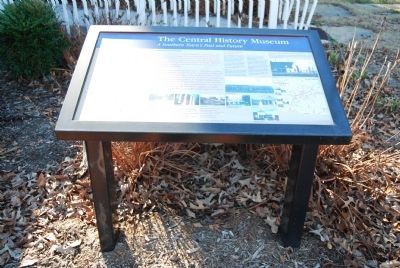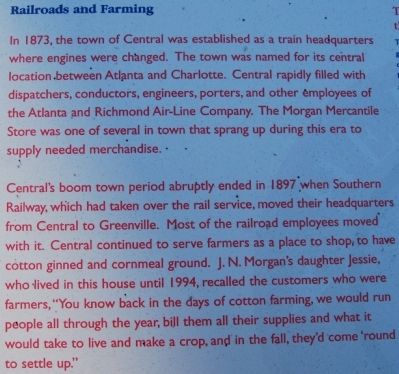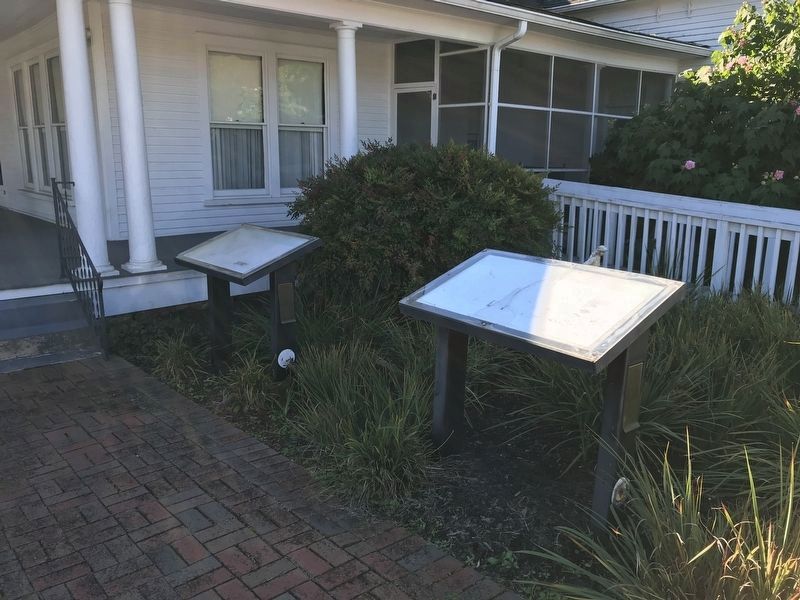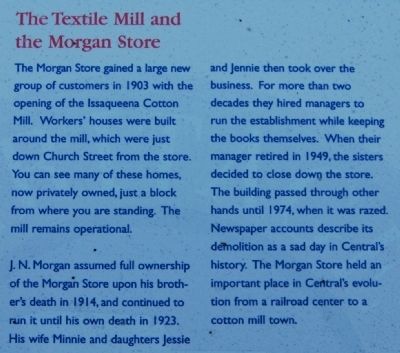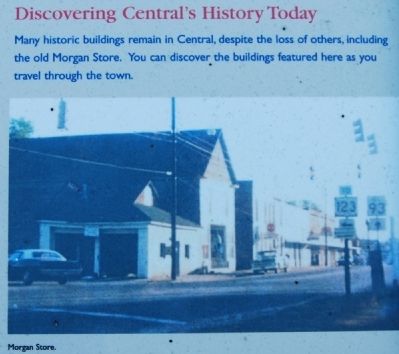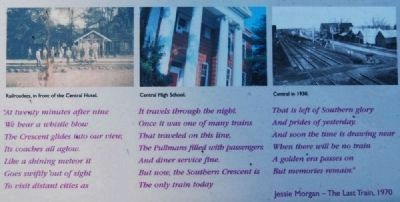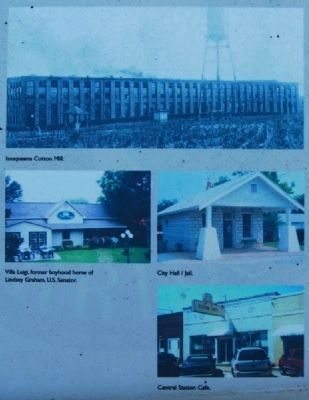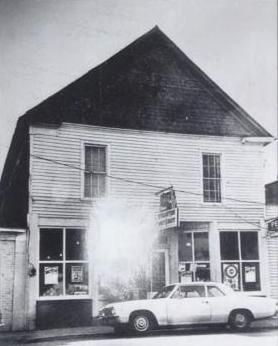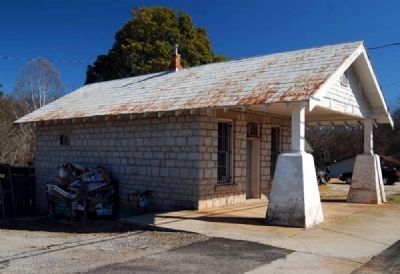Central in Pickens County, South Carolina — The American South (South Atlantic)
The Central History Museum
A Southern Town's Past and Future
Railroads and Farming
In 1873, the town of Central was established as a train headquarters where engines were changed. The town was named for its central location between Atlanta and Charlotte. Central rapidly filled with dispatchers, conductors, engineers, porters, and other employees of the Atlanta and Richmond Air-Line Company. The Morgan Mercantile Store was one of several in town that sprang up during this era to supply needed merchandise.
Central's boom town period abruptly ended in 1897 when Southern Railway, which had taken over the rail service, moved their headquarters from Central to Greenville. Most of the railroad employees moved with it. Central continued to serve farmers as a place to stop, to have cotton ginned and cornmeal ground. J.N. Morgan's daughter Jessie, who lived in this house until 1994, recalled the customers who were farmers, "You know back in the days of cotton farming, we would run people all through the year, bill them all their supplies and what it would take to live and make a crop, and in the fall, they'd come 'roud to settle up."
The Textile Mill and the Morgan Store
The Morgan Store gained a large new group of customers in 1903 with the opening of the Issaqueena Cotton Mill. Workers' houses were built around the mill, which were just down Church Street from the store. You can see many of these homes, now privately owned, just a block from where you are standing. The mill remains operational.
J.N. Morgan assumed full ownership of the Morgan Store upon his brother's death in 1914, and continued to run it until his own death in 1923. His wife Minnie and daughters Jessie and Jennie then took over the business. For more than two decades they hired managers to run the establishment while keeping the books themselves. When their manager retired in 1949, the sisters decided to close down the store. The building passed through other hands until 1974, when it was razed. Newspaper accounts describe its demolition as a sad day in Central's history. The Morgan Store held an important place in Central's evolution from a railroad center to a cotton mill town.
Discovering Central's History Today
Many historic buildings remain in Central, despite the loss of others, including the old Morgan Store. You can discover the buildings featured here as you travel through town.
The Last Train
by Jessie Morgan
At twenty minutes after nine
We hear a whistle blow
The Crescent glides into our view,
Its coaches all aglow.
Like a shining meteor it
Goes swiftly out of sight
To visit distance cities as
It travels through the night.
Once it
was one of many trains
That traveled on this line,
The Pullmans filled with passengers
And diner service fine.
But now, the Southern Crescent is
The only train today
That is left of Southern glory
And price of yesterday.
And soon the time is drawing near
When there will be no train
A golden era passes on
But memories remain.
Erected by South Carolina Heritage Corridor.
Topics and series. This historical marker is listed in these topic lists: Agriculture • Industry & Commerce • Railroads & Streetcars • Settlements & Settlers. In addition, it is included in the South Carolina Heritage Corridor series list. A significant historical year for this entry is 1873.
Location. 34° 43.3′ N, 82° 46.783′ W. Marker has been reported unreadable. Marker is in Central, South Carolina, in Pickens County. Marker is on Church Street. Touch for map. Marker is at or near this postal address: 401 Church Street, Central SC 29630, United States of America. Touch for directions.
Other nearby markers. At least 10 other markers are within walking distance of this location. A different marker also named The Central History Museum (here, next to this marker); Bertha Evans Morgan Rose Garden (within shouting distance of this marker); Central Railroad Depot & Red Caboose (approx. 0.2 miles away); The Werner Family (approx.
0.2 miles away); A Community Born of the Railroad (approx. 0.2 miles away); The Central Railroad Hotel (approx. ¼ mile away); Central (approx. ¼ mile away); Billy Weems (approx. ¼ mile away); Central, South Carolina (approx. ¼ mile away); Freedom's Hill Church (approx. one mile away). Touch for a list and map of all markers in Central.
Also see . . .
1. City of Central. City website homepage:
Information on the community with links to government, police, and recreation. (Submitted on January 23, 2009, by Brian Scott of Anderson, South Carolina.)
2. Central, South Carolina. Central is a town in Pickens County, South Carolina, United States. Contrary to its name, it is not at all near the central area of South Carolina. (Submitted on January 23, 2009, by Brian Scott of Anderson, South Carolina.)
3. Central Heritage Society. In planning the 1993 Central Railroad Festival (Labor Day Weekend) several local citizens were asked to prepare an exhibit to inform the public about Central’s history. (Submitted on January 23, 2009, by Brian Scott of Anderson, South Carolina.)
4. Atlanta and Richmond Air-Line Company. The Atlanta & Richmond Air-Line was organized in North Carolina in 1870, combining the Georgia Air-Line Railroad Company and the Air-Line Railroad Company of South Carolina. (Submitted on January 23, 2009, by Brian Scott of Anderson, South Carolina.)

Photographed By Clemson University
10. Daniel Keating Norris
November 1, 1846-January 23, 1905
November 1, 1846-January 23, 1905
Norris served as a member of the Clemson Board of Trustees from 1888-1905. Norris Hall is named for him, as is the town of Norris, South Carolina.
Click for more information.
Click for more information.
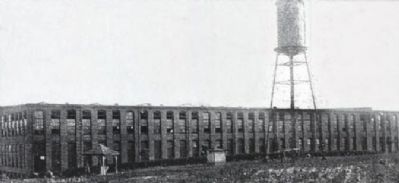
Pickens County by Piper Peters Aheron
11. Issaqueena Mill
D.K. Norris led fund-raising efforts to establish capital for the Issaqueena Mill. When the mill opened in 1904, kerosene lamps were used for lighting. Outhouses served as employee restrooms and the machinery was powered by steam engines and boilers, which were wood burners that were eventually replaced by coal burning units. In 1930 the mill went into receivership. During the Great Depression employees took a 15% cut in pay. The mill remained open under court order from 1930 until 1935, and by the 1950s Issaqueena Mill had become Plant No. 12 of the Cannon Mills Company. In 1970, the mill turned out 29 million yards of sheeting material. The plant employed about 345 people. (Source: Pickens County by Piper Peters Aheron (2000), pg 38.)
Credits. This page was last revised on June 25, 2022. It was originally submitted on January 23, 2009, by Brian Scott of Anderson, South Carolina. This page has been viewed 1,032 times since then and 27 times this year. Photos: 1, 2. submitted on January 23, 2009, by Brian Scott of Anderson, South Carolina. 3. submitted on November 9, 2021, by Duane and Tracy Marsteller of Murfreesboro, Tennessee. 4, 5. submitted on January 23, 2009, by Brian Scott of Anderson, South Carolina. 6, 7. submitted on December 27, 2011, by Brian Scott of Anderson, South Carolina. 8. submitted on January 22, 2009, by Brian Scott of Anderson, South Carolina. 9, 10, 11. submitted on April 16, 2010, by Brian Scott of Anderson, South Carolina.
